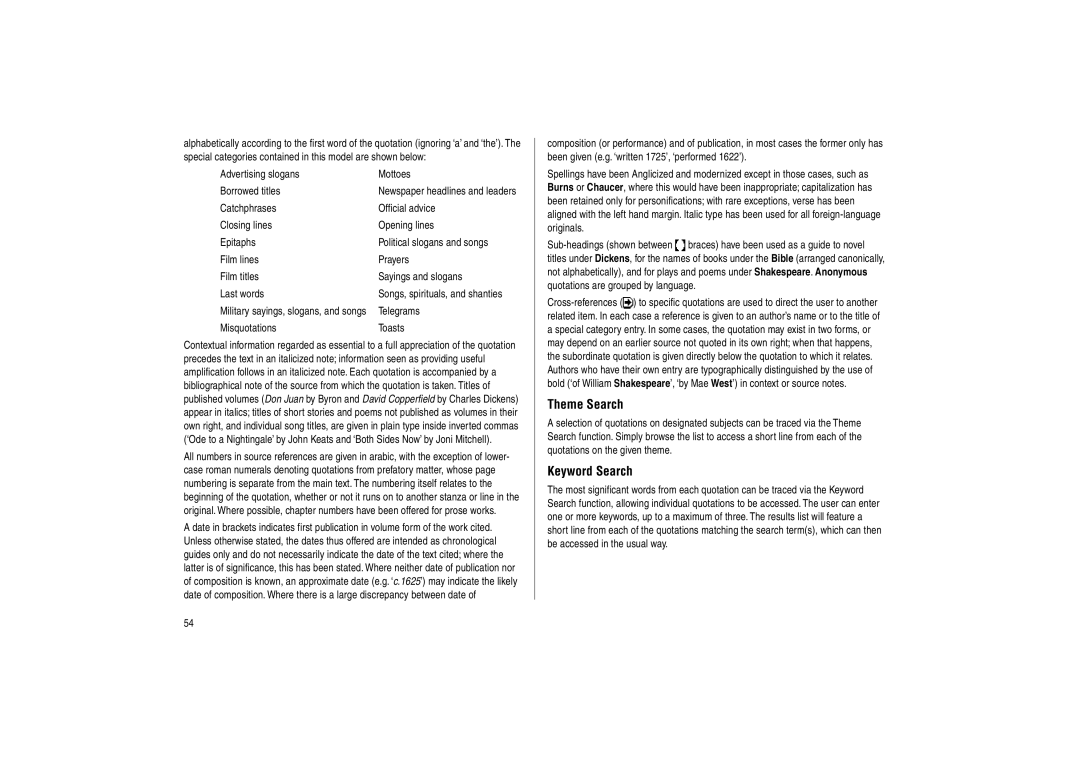alphabetically according to the first word of the quotation (ignoring ‘a’ and ‘the’). The special categories contained in this model are shown below:
Advertising slogans | Mottoes |
Borrowed titles | Newspaper headlines and leaders |
Catchphrases | Official advice |
Closing lines | Opening lines |
Epitaphs | Political slogans and songs |
Film lines | Prayers |
Film titles | Sayings and slogans |
Last words | Songs, spirituals, and shanties |
Military sayings, slogans, and songs | Telegrams |
Misquotations | Toasts |
Contextual information regarded as essential to a full appreciation of the quotation precedes the text in an italicized note; information seen as providing useful amplification follows in an italicized note. Each quotation is accompanied by a bibliographical note of the source from which the quotation is taken. Titles of published volumes (Don Juan by Byron and David Copperfield by Charles Dickens) appear in italics; titles of short stories and poems not published as volumes in their own right, and individual song titles, are given in plain type inside inverted commas (‘Ode to a Nightingale’ by John Keats and ‘Both Sides Now’ by Joni Mitchell).
All numbers in source references are given in arabic, with the exception of lower- case roman numerals denoting quotations from prefatory matter, whose page numbering is separate from the main text. The numbering itself relates to the beginning of the quotation, whether or not it runs on to another stanza or line in the original. Where possible, chapter numbers have been offered for prose works.
A date in brackets indicates first publication in volume form of the work cited. Unless otherwise stated, the dates thus offered are intended as chronological guides only and do not necessarily indicate the date of the text cited; where the latter is of significance, this has been stated. Where neither date of publication nor of composition is known, an approximate date (e.g. ‘c.1625’) may indicate the likely date of composition. Where there is a large discrepancy between date of
composition (or performance) and of publication, in most cases the former only has been given (e.g. ‘written 1725’, ‘performed 1622’).
Spellings have been Anglicized and modernized except in those cases, such as Burns or Chaucer, where this would have been inappropriate; capitalization has been retained only for personifications; with rare exceptions, verse has been aligned with the left hand margin. Italic type has been used for all
![]()
![]() braces) have been used as a guide to novel titles under Dickens, for the names of books under the Bible (arranged canonically, not alphabetically), and for plays and poems under Shakespeare. Anonymous quotations are grouped by language.
braces) have been used as a guide to novel titles under Dickens, for the names of books under the Bible (arranged canonically, not alphabetically), and for plays and poems under Shakespeare. Anonymous quotations are grouped by language.
![]() ) to specific quotations are used to direct the user to another related item. In each case a reference is given to an author’s name or to the title of a special category entry. In some cases, the quotation may exist in two forms, or may depend on an earlier source not quoted in its own right; when that happens, the subordinate quotation is given directly below the quotation to which it relates. Authors who have their own entry are typographically distinguished by the use of bold (‘of William Shakespeare’, ‘by Mae West’) in context or source notes.
) to specific quotations are used to direct the user to another related item. In each case a reference is given to an author’s name or to the title of a special category entry. In some cases, the quotation may exist in two forms, or may depend on an earlier source not quoted in its own right; when that happens, the subordinate quotation is given directly below the quotation to which it relates. Authors who have their own entry are typographically distinguished by the use of bold (‘of William Shakespeare’, ‘by Mae West’) in context or source notes.
Theme Search
A selection of quotations on designated subjects can be traced via the Theme Search function. Simply browse the list to access a short line from each of the quotations on the given theme.
Keyword Search
The most significant words from each quotation can be traced via the Keyword Search function, allowing individual quotations to be accessed. The user can enter one or more keywords, up to a maximum of three. The results list will feature a short line from each of the quotations matching the search term(s), which can then be accessed in the usual way.
54
